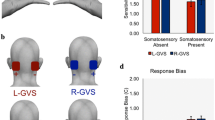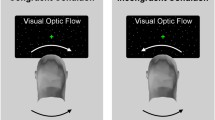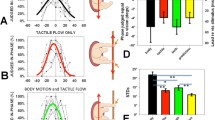Abstract
Passive rotation has been shown to alter temporal-order judgments for tactile stimuli delivered to the hands giving an advantage to the leading hand. Here we measure thresholds for detecting stimulus onset asynchrony for touches on the hands during tilt to the left or right and during galvanic vestibular stimulation (GVS) that evoked illusory tilt. During tilt to one side, the effect of gravity on the otoliths is equivalent to a physical acceleration away from that side (e.g., tilt left is equivalent to accelerating rightwards). We therefore predicted a “leading hand advantage” for the hand opposite to the tilt direction. Thresholds for detecting asynchronicity for left-hand-first and right-hand-first touches (defined as correct detection 75% of the time) were measured separately using interleaved adaptive staircases for 15 participants. For both physical and illusory tilt there was a temporal advantage for stimuli presented to the hand contralateral to the tilt—equivalent to the “leading hand” during passive rotation. That is, there was a temporal advantage for the upward hand (for physical tilt) and for the anodal-side hand (for illusory tilt caused by GVS). These results are discussed in terms of attention and direct sensory components evoking the “leading hand” bias. These findings add to the emerging understanding of the pervasive role of vestibular activity in many aspects of cognitive processing.




Similar content being viewed by others
Notes
QUEST staircase initial parameters: ± 60 ms (this is the initial “best guess” of the thresholds which determines which SOA it should test first); standard deviation 37.5 ms (the authors of the QUEST algorithm suggest a liberal standard deviation of the guesses to improve accuracy), step resolution 1.5 ms. The minimum SOA was set to 0.15 ms.
Caloric irrigation involves irrigating the external auditory meatus with warm or cold water; thus inducing convection currents in the vestibular endolymph and stimulating the vestibular apparatus without physical motion.
References
Amemiya T, Hirota K, Ikei Y (2013) Perceived forward velocity increases with tactile flow on seat pan. In: 2013 IEEE virtual real., pp 141–142. https://doi.org/10.1109/VR.2013.6549402
Azañón E, Soto-Faraco S (2007) Alleviating the “crossed-hands” deficit by seeing uncrossed rubber hands. Exp Brain Res 182:537–548. https://doi.org/10.1007/s00221-007-1011-3
Azañón E, Soto-Faraco S (2008) Changing reference frames during the encoding of tactile events. Curr Biol 18:1044–1049. https://doi.org/10.1016/j.cub.2008.06.045
Craig JC (2003) The effect of hand position and pattern motion on temporal order judgments. Percept Psychophys 65:779–788
Craig JC, Belser AN (2006) The crossed-hands deficit in tactile temporal-order judgments: the effect of training. Perception 35:1561–1572. https://doi.org/10.1068/p5481
Craig JC, Busey TA (2003) The effect of motion on tactile and visual temporal order judgments. Percept Psychophys 65:81–94. https://doi.org/10.3758/BF03194785
Cravo AM, Claessens PME, Baldo MVC (2011) The relation between action, predictability and temporal contiguity in temporal binding. Acta Psychol (Amst) 136:157–166. https://doi.org/10.1016/j.actpsy.2010.11.005
Day BL, Fitzpatrick RC (2005) Virtual head rotation reveals a process of route reconstruction from human vestibular signals. J Physiol 567:591–597. https://doi.org/10.1113/jphysiol.2005.092544
Deecke L, Becker W, Jurgens R, Mergner T (1979) Interaction of vestibular and somatosensory afferents for perception and postural control. Agressologie 20:179–184
Ferrè ER, Haggard P (2015) Vestibular–somatosensory interactions: a mechanism in search of a function? Multisens Res 28:559–579. https://doi.org/10.1163/22134808-00002487
Ferrè ER, Bottini G, Haggard P (2011a) Vestibular modulation of somatosensory perception. Eur J Neurosci 34:1337–1344. https://doi.org/10.1111/j.1460-9568.2011.07859.x
Ferrè ER, Sedda A, Gandola M, Bottini G (2011b) How the vestibular system modulates tactile perception in normal subjects: a behavioural and physiological study. Exp Brain Res 208:29–38
Ferrè ER, Bottini G, Haggard P (2012) Vestibular inputs modulate somatosensory cortical processing. Brain Struct Funct 217:859–864. https://doi.org/10.1007/s00429-012-0404-7
Ferrè ER, Bottini G, Iannetti GD, Haggard P (2013) The balance of feelings: vestibular modulation of bodily sensations. Cortex 49:748–758. https://doi.org/10.1016/j.cortex.2012.01.012
Ferrè ER, Kaliuzhna M, Herbelin B et al (2014) Vestibular–somatosensory interactions: effects of passive whole-body rotation on somatosensory detection. PLoS One 9:e86379. https://doi.org/10.1371/journal.pone.0086379
Ferrè ER, Walther LE, Haggard P (2015) Multisensory interactions between vestibular, visual and somatosensory signals. PLoS One 10:e0124573. https://doi.org/10.1371/journal.pone.0124573
Figliozzi F, Guariglia P, Silvetti M et al (2005) Effects of vestibular rotatory accelerations on covert attentional orienting in vision and touch. J Cogn Neurosci 17:1638–1651. https://doi.org/10.1162/089892905774597272
Fitzpatrick RC, Day BL (2004) Probing the human vestibular system with galvanic stimulation. J Appl Physiol 96:2301–2316. https://doi.org/10.1152/japplphysiol.00008.2004
Fujisaki W, Shimojo S, Kashino M, Nishida S (2004) Recalibration of audiovisual simultaneity. Nat Neurosci 7:773–778. https://doi.org/10.1167/3.9.34
Gallace A, Spence C (2005) Visual capture of apparent limb position influences tactile temporal order judgments. Neurosci Lett 379:63–68
Goldberg JM, Fernandez C, Smith CE, Fernandez C (1984) Relation between discharge regularity and responses to externally applied galvanic currents in vestibular nerve afferents of the squirrel monkey. J Neurophysiol 51:1236–1256
Harrar V, Harris LR (2005) Simultaneity constancy: detecting events with touch and vision. Exp Brain Res 166:465–473. https://doi.org/10.1007/s00221-005-2386-7
Harrar V, Harris LR (2008) The effect of exposure to asynchronous audio, visual, and tactile stimulus combinations on the perception of simultaneity. Exp Brain Res 186:517–524. https://doi.org/10.1007/s00221-007-1253-0
Harris LR, Sakurai K, Beaudot WHA (2017) Tactile flow overrides other cues to self motion. Sci Rep 7:6592. https://doi.org/10.1038/s41598-017-04864-6
Jeka JJ, Lackner JR (1995) The role of haptic cues from rough and slippery surfaces in human postural control. Exp Brain Res 103:267–276
Kuroki S, Watanabe J, Kawakami N et al (2010) Somatotopic dominance in tactile temporal processing. Exp Brain Res 203:51–62. https://doi.org/10.1007/s00221-010-2212-8
Longo MR, Mancini F, Haggard P (2015) Implicit body representations and tactile spatial remapping. Acta Psychol (Amst) 160:77–87. https://doi.org/10.1016/j.actpsy.2015.07.002
Lopez C, Blanke O (2011) The thalamocortical vestibular system in animals and humans. Brain Res Rev 67:119–146. https://doi.org/10.1016/j.brainresrev.2010.12.002
Lopez C, Blanke O, Mast FW (2012) The human vestibular cortex revealed by coordinate-based activation likelihood estimation meta-analysis. Neuroscience 212:159–179. https://doi.org/10.1016/j.neuroscience.2012.03.028
Mast FW, Preuss N, Hartmann M, Grabherr L (2014) Spatial cognition, body representation and affective processes: the role of vestibular information beyond ocular reflexes and control of posture. Front Integr Neurosci 8:44. https://doi.org/10.3389/fnint.2014.00044
Mergner T, Rosemeier T (1998) Interaction of vestibular, somatosensory and visual signals for postural control and motion perception under terrestrial and microgravity conditions—a conceptual model. Brain Res Rev 28:118–135. https://doi.org/10.1016/S0165-0173(98)00032-0
Pfeiffer C, van Elk M, Bernasconi F, Blanke O (2016) Distinct vestibular effects on early and late somatosensory cortical processing in humans. Neuroimage 125:208–219. https://doi.org/10.1016/j.neuroimage.2015.10.004
Rohde M, Greiner L, Ernst MO (2014) Asymmetries in visuomotor recalibration of time perception: does causal binding distort the window of integration? Acta Psychol (Amst) 147:127–135. https://doi.org/10.1016/j.actpsy.2013.07.011
Rorden C, Karnath HO, Driver J (2001) Do neck-proprioceptive and caloric-vestibular stimulation influence covert visual attention in normals, as they influence visual neglect? Neuropsychologia 39:364–375
Shore DI, Spry E, Spence C (2002) Confusing the mind by crossing the hands. Brain Res Cogn Brain Res 14:153–163
Shore DI, Gray K, Spry E, Spence C (2005) Spatial modulation of tactile temporal-order judgments. Perception 34:1251–1262. https://doi.org/10.1068/p3313
Spence C, Squire S (2003) Multisensory integration: maintaining the perception of synchrony. Curr Biol 13:R519–R521
Spence C, Shore DI, Klein RM (2001) Multisensory prior entry. J Exp Psychol 130:799–832
Teramoto W, Watanabe H, Umemura H, Kita S (2008) Change of temporal-order judgment of sounds during long-lasting exposure to large-field visual motion. Perception 37:1649–1666. https://doi.org/10.1068/p5692
Watson A, Pelli D (1983) QUEST—a Bayesian adaptive psychophysical method. Percept Psychophys 33:113–120
Yamamoto S, Kitazawa S (2001) Reversal of subjective temporal order due to arm crossing. Nat Neurosci 4:759–765. https://doi.org/10.1038/89559
Yamamoto S, Moizumi S, Kitazawa S (2005) Referral of tactile sensation to the tips of L-shaped sticks. J Neurophysiol 93:2856–2863. https://doi.org/10.1152/jn.01015.2004
Yarrow K, Jahn N, Durant S, Arnold DH (2011) Shifts of criteria or neural timing? The assumptions underlying timing perception studies. Conscious Cogn 20:1518–1531. https://doi.org/10.1016/j.concog.2011.07.003
Zampini M, Harris C, Spence C (2005) Effect of posture change on tactile perception: impaired direction discrimination performance with interleaved fingers. Exp brain Res 166:498–508. https://doi.org/10.1007/s00221-005-2390-y
Zarzecki P, Bakker DA, Blum PS, Herman D (1983) Convergence of sensory inputs upon projection neurons of somatosensory cortex—vestibular, neck, head, and forelimb Inputs. Exp Brain Res 50:408–414
Acknowledgements
We sincerely thank all of our participants for volunteering in this study, and Ben Shachar for his assistance in testing participants. This research was supported by the Natural Sciences and Engineering Research Council of Canada (46271-2015) Discovery Grant to LRH. SSM is supported by the Natural Sciences and Engineering Research Council of Canada, Toronto Rehabilitation’s TD Graduate Scholarship for People with Disabilities, and York University.
Author information
Authors and Affiliations
Corresponding author
Rights and permissions
About this article
Cite this article
Moro, S.S., Harris, L.R. Vestibular–somatosensory interactions affect the perceived timing of tactile stimuli. Exp Brain Res 236, 2877–2885 (2018). https://doi.org/10.1007/s00221-018-5346-8
Received:
Accepted:
Published:
Issue Date:
DOI: https://doi.org/10.1007/s00221-018-5346-8




